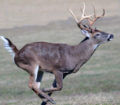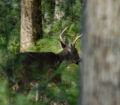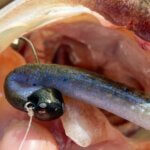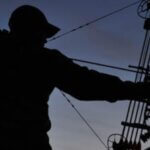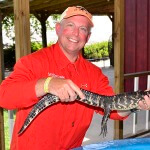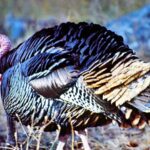 Editor’s Note: Can you identify a buck fast and get off a clear shot before he vanishes in thick brush? Although not easy, there are ways you can speed-up your reaction time. How does a batter see a ball coming toward the plate at 90 mph, and time his swing to hit the ball? Travis Fryman, who played with the Detroit Tigers and the Cleveland Indians for 13 years, batting in 1,022 runs, making 223 home runs and five times earning MLB All Star status, says, “I not only can see the ball as it leaves the pitcher’s hand, but I also can see the seams of ball as it rotates toward me.” Fryman, a longtime hunter and fisherman, uses his vision skills he sharpened working with a developmental optometrist on his baseball hitting to hunt more effectively. The quicker you can see and identify a buck and determine the direction he’s traveling, the quicker and more accurately you’ll shoot. You must understand the difference between eyesight and vision. If you start now, by the time deer season arrives in the fall, your ability to see deer greatly will have improved. NFL teams use developmental optometrists to teach quarterbacks to spot open receivers. One friend of our son’s went to a developmental optometrist for 6 months to improve his vision to get accepted into the Navy pilot program.
Editor’s Note: Can you identify a buck fast and get off a clear shot before he vanishes in thick brush? Although not easy, there are ways you can speed-up your reaction time. How does a batter see a ball coming toward the plate at 90 mph, and time his swing to hit the ball? Travis Fryman, who played with the Detroit Tigers and the Cleveland Indians for 13 years, batting in 1,022 runs, making 223 home runs and five times earning MLB All Star status, says, “I not only can see the ball as it leaves the pitcher’s hand, but I also can see the seams of ball as it rotates toward me.” Fryman, a longtime hunter and fisherman, uses his vision skills he sharpened working with a developmental optometrist on his baseball hitting to hunt more effectively. The quicker you can see and identify a buck and determine the direction he’s traveling, the quicker and more accurately you’ll shoot. You must understand the difference between eyesight and vision. If you start now, by the time deer season arrives in the fall, your ability to see deer greatly will have improved. NFL teams use developmental optometrists to teach quarterbacks to spot open receivers. One friend of our son’s went to a developmental optometrist for 6 months to improve his vision to get accepted into the Navy pilot program.
Often hunters overlook the most-critical tool to successful hunting – vision. For many years, I assumed that either you could see well, or you needed glasses. I also thought that if you wore glasses, you could see better than people who didn’t have glasses but needed them. I supposed that 20/20 vision and experience in hunting and shooting were enough to make a sportsman an excellent woodsman. However, I have learned that no matter how well you see in the woods, you can be taught to see better, and to recognize what you see more quickly and accurately. Just like shooting, this is a learned skill that is necessary for successful hunting.
“There is a difference between eyesight and vision,” the late Dr. F. J. Day, a developmental optometrist from Birmingham, Alabama, from whom I sought advice, told me. “Eyesight is what enables you to recognize a certain size letter at a specific distance on an eye chart. Vision is the ability to use what you see to perform some task. A typical example of the difference between eyesight and vision is what someone does when he sees a truck coming. With his eyesight, he observes a truck coming his way. But by using his vision, he knows what he must do to keep from getting run over.”
 When I was stalking that deer (see Day 1), I guessed that what I was looking at was a deer. But I was unable to distinguish the animal from its background and to determine whether it was a buck or a doe. With training, however, an outdoorsman can learn to make those visual distinctions rapidly.
When I was stalking that deer (see Day 1), I guessed that what I was looking at was a deer. But I was unable to distinguish the animal from its background and to determine whether it was a buck or a doe. With training, however, an outdoorsman can learn to make those visual distinctions rapidly.
A doctor researching sports-vision skills for the American Optometric Association, Dr. Gary Etting of Encino, California, has worked with the U. S. Olympic trap and skeet and volleyball teams to improve their members’ abilities to see more quickly and then to react properly to what they see. “Being able to see deer in the woods, distinguishing bucks from does, perceiving direction of flight and then reacting quickly enough to take a shot are learned skills that can be developed and improved,” Dr. Etting says. “People who are able to do this naturally usually have learned to see better than others and have more experience using their visual systems than others. But, no matter how good someone’s basic visual abilities are, they can be enhanced.”
A developmental optometrist can determine in what area a hunter’s visual skill is deficient and then can develop a personalized therapy program to improve those skills. For a listing of doctors in your area, contact the non-profit Optometric Extension Program Foundation at https://www.oepf.org or 410-561-3791. Check out the American Optometric Association (www.aoa.org).
To learn more about hunting deer with John E. Phillips’ Amazon Kindle eBooks, print books and Audible books and Nook books, click here at https://johninthewild.com/books/#deer. You can type in the name of the book and download it to your Kindle, and/or download a Kindle app for your iPad, SmartPhone or computer. For a free download on how to make jerky from venison to provide a protein-rich snack, choose “How to Prepare Venison Jerky: The Ultimate Snack Food” at johninthewild.com/free-books.

